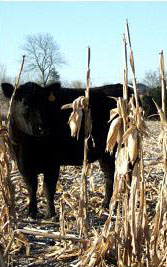Possibility of Nitrate Toxicity in Corn

Nitrate toxicity may be a problem for farmers grazing corn or feeding green-chop this fall. There are many factors to consider when deciding if livestock are at risk of nitrate toxicity. Drought conditions and high levels of nitrogen in the soil can cause prime conditions for high nitrates in plants. During times of drought, higher levels of nitrogen are taken up by the plants. Risk is increased if soil nitrogen levels are high. High levels of nitrates in the bloodstream and rumen reduce the ability of oxygen to be carried in the blood to tissues in the body. Symptoms of nitrate toxicity include brown color of blood and mucous membranes, depression, weakness, staggering, incoordination, excess salivation, abortion, and possibly death.
Sorghum, sudangrass, sorghum-sudan hybrids, Johnsongrass, corn, millet, and some weeds have a higher risk of nitrates than other forages. If grazing corn this fall, farmers need to be aware of possible nitrate toxicity problems. Nitrate concentration is highest in the lower parts of the stalks. When used for silage, corn’s nitrate levels are reduced through the fermentation process. Feeding these crops as hay does not reduce nitrate levels. If corn or silage is questionable, always test it for nitrate content before using it as a feed source. Contact your local county extension agent for information on testing your forages for nitrate content.
Categories:
Summer
Forage Related Disorders


